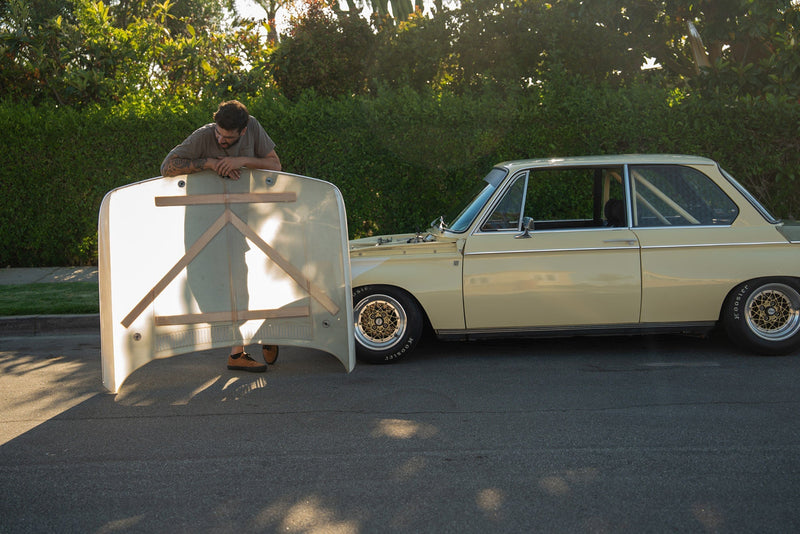On the surface, this car’s story is quintessential Volvo. It’s owned by a guy named Mike who lives in New England with his wife Emily and a pair of golden retrievers on a tree-shaded property with a red barn and a long gravel driveway. Much like the boarding school in the background of these photos, this is brochure-grade 240 territory.
But while many the Americans that bought these Swedish imports brand new may have fit neatly into the “preppy and practical L.L. Bean shopper” bucket, the population of 240 owners has since overflowed and spread across a much wider automotive landscape, thanks only in part to the sheer volume of 240s produced. It’s similar to the Beetle in many ways, as both are widely known, instantly recognizable, mass-produced, and affordable cars with seemingly innate abilities to adopt whatever use cases its owners have in mind. It’s pretty unique when a product designed for mass appeal can also burrow into so many niches.


These cars’ paths can be as humble as the typical “painter’s special” 240 wagon workhorse with the requisite faded blue paint and a ladder on the roof, or they can go in the direction that Mike Kornely has taken with his two-door turbo build.
Even among fast Volvo 240s, this 1979 242 DL is unique. It produces about 400 horsepower at the rear wheels, but that hasn’t been achieved through typical means. There’s no small block V8 under this big beige hood, and while there’s nothing wrong (and frankly no better solution to the bang and buck equation) with those engine swaps, the paths less traveled are often more interesting.
Getting this 242 from the state he bought it in to where it is now took its share of late nights in the garage (and, as any young enthusiast car builder can attest, even earlier mornings trawling the internet afterwards), but Mike’s relationship with cars had been leading up to this project before he even decided to take it on. Namely, Mike grew up with a Volvo and Saab shop in his garage.





In the 1980s, Mike’s dad, (also named Mike), moved to New England and put his engineering background to use at home not just on the occasional leaky pipe, but on the various cars brimming out of the garage into the driveway. Though he grew up swayed by the muscle and pony cars of his adolescence, Mike’s dad also had an affinity for what could be described as the opposite of rowdy and brash: Swedish cars. And so he found himself running a repair business with predominantly Volvo and Saab-driving clientele. His imagination and ability were never going to be sated with maintenance and upkeep though, and he made time to work on more fun projects too, like Newman-style LS1 and T56-equipped Volvo V90s.
Instead of playing basketball in the driveway growing up, Mike learned about cars, and developed a liking for Saabs in particular. His first car was a Saab that he and his dad worked on together throughout high school, but over time—and thanks to cars like that V8-swapped V90 and its siren song of screaming rear tires—Mike’s attention turned to Volvos. He started poking around the classifieds section on forums, just getting a sense for what was available and for how much, when he found a few nice examples of the two-door 240, or 242. The mix of pricing and timing and condition didn’t align back then, so he settled for a 940 Turbo wagon instead.



He enjoyed the car, but kept looking for 242s in the meantime, eventually coming across this one somewhat mis-listed in the “car parts” section of Craigslist as simply, “Volvo.” Intrigued by what Mike could tell was a 242, he called the number and found a kind elderly gentlemen on the other end. Now, the Old Man and the Volvo is another classic 240 story, but this particular Volvo hasn’t followed the typical plot. The owner told Mike that his wife used to drive the car in the early 1990s before he’d had the bodywork and paint redone in anticipation of a Chevy small block swap that he eventually realized was never going to come to fruition, hence the listing. This conversation took place in 2013, but the car had been hibernating in the barn since 2002. Its straight panels and then-fresh coat of paint had received a George W. Bush bumper sticker but not much else, and certainly not a V8, while the rest of the car started to succumb to its fate of long-term sitting as the immobilized years stacked up.
With New England’s four seasons and the barn’s dirt floors, the 242 had begun to rust from the bottom up, and since it’d sat for more than a decade in the same spot, the wheel bearings were basically locked in place. When Mike came to take the car to its new home, he had to first literally drag it out of the barn and onto the trailer. A grease prescription and some crispy floor panels weren’t going to deter Mike from getting it running and driving and registered again, and he made short work of digging into his new car… Only to find a very long-term project waiting for him underneath.




With hindsight he says a better plan would be to part out what was salvageable and find another one to start with, but he also remembers being “dumb and bored,” so he stuck with it, and has since rebuilt and/or modified the entirety of this 242. A few donor cars gave up their parts to make it happen, but nothing would have happened without Mike pouring hundreds of hours of time into putting everything together in one tidy Swedish box.
From orchestrating a Rube Goldberg-esque chain of logistics to ship original exterior trim pieces around the world to hand-shaping the rear seat foam and upholstering it with Recaro fabric to match the gradient pattern of the Recaro SRD front seats, spending 100 forearm-obliterating hours polishing the Epsilon wheels to rebuilding the entire suspension system, Mike has expended some serious effort to build this thing. And from what we can tell, he’s never opted for the path of least resistance either. There are shorter ways to cut up an old Volvo and turn it into a freakish horsepower dispenser, but Mike wanted to keep this car faithful to the Volvo 240 tuning history, and went out of his way to find discontinued, one-off, and otherwise plain old rare parts from the companies and individuals that helped define the 240 aftermarket.
For instance, you’ll find a lot of IPD pieces, but also deeper cuts like the long-gone, only-known-to-some Volvo speed shop, RSI. Mike started the motor build with a Volvo B230FT inline-four that he bought from someone who’d already prepped the block for a drag racing build (forged rods and pistons, hardened crank, etc.), which Mike then topped with an eight-valve head Volvo head that RSI had shaped and ported. It’s a rare piece, and while the 16-valve heads are more common and easier to make power with, the RSI piece represented a bit of Volvo tuning lore that Mike was happy to incorporate into the project. Besides, it’s about as built as these eight-valve heads can get, with a custom-made cam from RSI operating an enlarged Ferrea-designed valvetrain.



The real boost comes from the turbocharger setup though, which is based around a tortoise-sized Borgwarner snail that’s spooled up thanks to a turbo exhaust manifold designed by RSI. The Volvo tuning history continues outside of the powertrain with Koni-shocked Kaplhenke Racing coilovers inside custom shortened front strut housings, IPD sway bars, Yoshifab strut and chassis braces, and a Koni shock and Eibach spring pairing for the rear solid axle. Along with Kaplhenke (and any stashes of NOS IPD parts), Yoshifab is one of the last remaining shops with a focus on vintage Volvo tuning, and Mike got in touch with them to help come up with his car’s clutch setup, which is a pretty serious carbon kevlar four-puck design that Mike’s converted with Tilton parts to be operate hydraulically, rather than by cable.
As it goes with complete builds carried out by people who can write the book, so to speak, there’s a lot that we’re leaving out. The parts list in its entirety isn’t necessary to get the point across that this car has been rebuilt to the extent of Ship of Theseus. It also goes without saying but bears clarifying that this is one of those car’s that’s never really “done.” Mike is the type of person to take things apart to not only learn how they work, but to learn how they can work better. It’s also not his only radically customized Volvo project, but we’ll save the wagon-turned-ute for another story.




























































